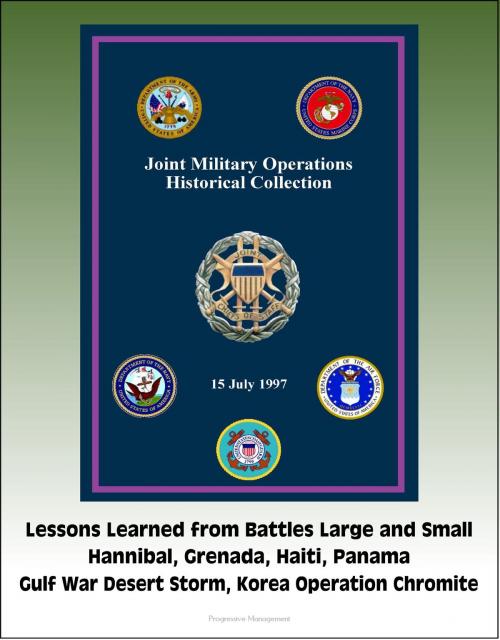Joint Military Operations Historical Collection: Lessons Learned from Battles Large and Small, Hannibal, Grenada, Haiti, Panama, Gulf War Desert Storm, Korea Operation Chromite
Nonfiction, History, Military, Strategy, United States| Author: | Progressive Management | ISBN: | 9781301704507 |
| Publisher: | Progressive Management | Publication: | September 15, 2013 |
| Imprint: | Smashwords Edition | Language: | English |
| Author: | Progressive Management |
| ISBN: | 9781301704507 |
| Publisher: | Progressive Management |
| Publication: | September 15, 2013 |
| Imprint: | Smashwords Edition |
| Language: | English |
Knowing the past and being able to use its lessons are major responsibilities of all military professionals. The Joint Military Operations Historical Collection (JMOHC) presents historical events that illustrate Joint Doctrine principles in Joint Force Employment. The selected US joint military operations include historical and modern operations that teach us universal lessons directly applicable to Joint Force Employment. The military actions covered in the JMOHC helped shape our current Joint Doctrine. By studying, understanding, and practicing this doctrine, we will enhance joint warfighting throughout the Armed Forces of the United States.
Among the historic incidents covered: Grenada, Panama, Haiti, Gettysburg, Civil War, Korean War, Caesar in Britain, von Moltke, World War I, Hannibal, Operation Chromite, Operation Urgent Fury, Operation Just Cause, Desert Shield, Desert Storm, Somalia, Uphold Democracy.
The Joint Military Operations Historical Collection (JMOHC) complements joint doctrine by providing historical military operations that illustrate fundamental principles of joint operations. These historical joint operations teach primary lessons in planning, deploying, and employing joint forces. The JMOHC has been developed to help military students, action officers, and planners understand key principles of Joint Force Employment. Joint doctrine is largely developed from the lessons of past operations. The JMOHC distills seven case histories for their relevance to Joint Force Employment and fundamental principles of joint doctrine. This document examines general principles of Joint Force Employment to link relevant historical lessons to current planning and joint operations. Each of the historical operations illustrates how fundamental joint doctrine principles were applied in specific circumstances. Military students and practitioners are invited to compare the case histories in this book to today's joint operations and principles to stimulate original thought and effective responses to future military challenges. Great leaders have always studied history. In their study they hope to see not only what happened but why. What were the processes that led to a certain action? Why was one action successful and another a failure? How can these lessons learned be used to help US forces fight as a team? Military personnel should take the time to read, study, and reflect upon thousands of years of recorded military history. Thucydides, Sun Tzu, Napoleon, and others have much to offer today's leaders. While historical case studies can extend the experience base of today's commanders and senior staff officers they should not, however, be viewed as a checklist for future operations. The purpose of the historical study is to stimulate thought, not rote imitation.
EXECUTIVE SUMMARY * MILITARY INCIDENT #1: THE IMPORTANCE OF TACTICS * MILITARY INCIDENT #2: BUILDING ON EXPERIENCE * CHAPTER I - VICKSBURG * MILITARY INCIDENT #3: THE PRICE OF POOR PLANNING * CHAPTER II - OPERATION CHROMITE * MILITARY INCIDENT #4: THE PRICE OF INFLEXIBILITY * CHAPTER III - OPERATION URGENT FURY * MILITARY INCIDENT #5: UNITY OF COMMAND * CHAPTER IV - OPERATION JUST CAUSE * MILITARY INCIDENT #6: FORCE WITHOUT CONCEPT * CHAPTER V - OPERATIONS DESERT SHIELD AND DESERT STORM * MILITARY INCIDENT #7: FACING THE UNEXPECTED AND UNTHINKABLE * CHAPTER VI - OPERATIONS IN SOMALIA * MILITARY INCIDENT #8: NEW MISSIONS, EARLY STRATEGIES * CHAPTER VII - OPERATION UPHOLD DEMOCRACY
Knowing the past and being able to use its lessons are major responsibilities of all military professionals. The Joint Military Operations Historical Collection (JMOHC) presents historical events that illustrate Joint Doctrine principles in Joint Force Employment. The selected US joint military operations include historical and modern operations that teach us universal lessons directly applicable to Joint Force Employment. The military actions covered in the JMOHC helped shape our current Joint Doctrine. By studying, understanding, and practicing this doctrine, we will enhance joint warfighting throughout the Armed Forces of the United States.
Among the historic incidents covered: Grenada, Panama, Haiti, Gettysburg, Civil War, Korean War, Caesar in Britain, von Moltke, World War I, Hannibal, Operation Chromite, Operation Urgent Fury, Operation Just Cause, Desert Shield, Desert Storm, Somalia, Uphold Democracy.
The Joint Military Operations Historical Collection (JMOHC) complements joint doctrine by providing historical military operations that illustrate fundamental principles of joint operations. These historical joint operations teach primary lessons in planning, deploying, and employing joint forces. The JMOHC has been developed to help military students, action officers, and planners understand key principles of Joint Force Employment. Joint doctrine is largely developed from the lessons of past operations. The JMOHC distills seven case histories for their relevance to Joint Force Employment and fundamental principles of joint doctrine. This document examines general principles of Joint Force Employment to link relevant historical lessons to current planning and joint operations. Each of the historical operations illustrates how fundamental joint doctrine principles were applied in specific circumstances. Military students and practitioners are invited to compare the case histories in this book to today's joint operations and principles to stimulate original thought and effective responses to future military challenges. Great leaders have always studied history. In their study they hope to see not only what happened but why. What were the processes that led to a certain action? Why was one action successful and another a failure? How can these lessons learned be used to help US forces fight as a team? Military personnel should take the time to read, study, and reflect upon thousands of years of recorded military history. Thucydides, Sun Tzu, Napoleon, and others have much to offer today's leaders. While historical case studies can extend the experience base of today's commanders and senior staff officers they should not, however, be viewed as a checklist for future operations. The purpose of the historical study is to stimulate thought, not rote imitation.
EXECUTIVE SUMMARY * MILITARY INCIDENT #1: THE IMPORTANCE OF TACTICS * MILITARY INCIDENT #2: BUILDING ON EXPERIENCE * CHAPTER I - VICKSBURG * MILITARY INCIDENT #3: THE PRICE OF POOR PLANNING * CHAPTER II - OPERATION CHROMITE * MILITARY INCIDENT #4: THE PRICE OF INFLEXIBILITY * CHAPTER III - OPERATION URGENT FURY * MILITARY INCIDENT #5: UNITY OF COMMAND * CHAPTER IV - OPERATION JUST CAUSE * MILITARY INCIDENT #6: FORCE WITHOUT CONCEPT * CHAPTER V - OPERATIONS DESERT SHIELD AND DESERT STORM * MILITARY INCIDENT #7: FACING THE UNEXPECTED AND UNTHINKABLE * CHAPTER VI - OPERATIONS IN SOMALIA * MILITARY INCIDENT #8: NEW MISSIONS, EARLY STRATEGIES * CHAPTER VII - OPERATION UPHOLD DEMOCRACY















